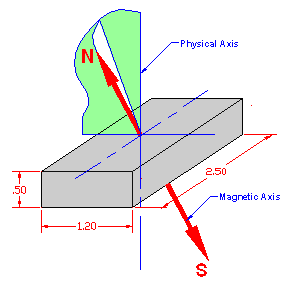This article covers the relationship between the physical axis and magnetic axis of permanent magnets, and methods of achieving the two axis on the same straight line. The perfect magnet will have the magnetic axis and the physical axis on this same straight line, and a perfect measurement will yield a value of Bx as a maximum, while the vector quantities By and Bz will remain at zero.

The Physical Axis
The physical dimensions of the magnet block describe the part; the line perpendicular to the pole face is defined as the magnet’s physical axis and the desired orientation of the magnet.
The Magnetic Axis
Draw a straight line between the “center of pole” of each of the magnet poles. This line is defined as the magnetic axis, and is the true orientation of the magnet.
Typically, we can expect that the physical axis and the magnetic axis will be within 5° of each other. To better guarantee, some alternate manufacturing methods have to be utilized, which can include statistical sorting, 100% inspection, and in-process controls. These are costly. In many cases, multiple methods may need to be utilized.
Using Statistical Processing
Engineering will estimate the anticipated yield. Subsequently, the Costing Department will take this into account. When we begin your job, the job will be over-run so we can achieve the order requirements with the anticipated losses. Parts will be 100% inspected to determine the deviation between the physical axis and the magnetic axis. Good parts are accepted; the parts that fall outside the specification are rejected.
Using 100% Inspection
This is similar to using Statistical Processing. Each magnet is inspected 100% in the three axis to determine compliance. This is done by testing and recording the values of the Bx, By and Bz components, then solving for the angular difference in each of the axis.
Using In-Process Controls
A master block from the die is ground on all faces. This block is then magnetized and characterized. From this we can determine the deviation of the magnetic axis to the physical axis. Engineering determines what angles have to be ground on each face to bring the physical axis and magnetic axis into alignment. The block is demagnetized and Production grinds the blocks to achieve the objectives of Engineering. The block is then returned to the Quality Department to determine compliance. If the block meets specifications, it is then released for further processing. If the specifications are not met, or is too close to proceed, Engineering provides further corrections and returns to Production to modify the dimensions and resubmit to Quality for testing. This is the most expensive solution and can typically only be done on Neodymium Iron Boron magnets. Samarium Cobalt is very difficult to demagnetize completely, hence this type of processing cannot be used.
Type of Tests Used
The most reliable method of testing the magnetic field is using a fluxmeter and a Helmholtz coil, or a Search Coil. Gaussmeters are not used to determine magnetic axis because the gaussmeter works on a “sampling” method. For larger magnets, a gaussmeter may be used; however, the test must be performed by mapping the field around the magnet. The accuracy of this test depends on the test set-up and the number of data points collected. The more data points the more accurate the test; however, the more costly the test.
Typical Production
MCE periodically tests production runs to determine the actual variations of the magnetic to physical axis. Although we guarantee a maximum deviation of 5°, data shows that our typical production provides for magnets with a variation of less than 2°.